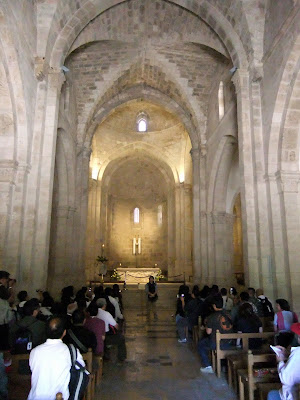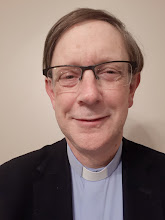23-24 April, 2010
I do not have a great deal to report from this period of time. I was mainly trying to catch up on my blogging!
On the morning of 23 April we went to places that I had already visited on the previous course - the Dominus Flevit Church, the Dormition Abbey, the Cenacle and St Peter's in Gallicantu (see previous blogs for information about these places).
One new thing about this visit to Dominus Flevit was that the Dean pointed out some ossuaries (bone boxes) that are kept on the site.
The burial practice for wealthier people at the time of Jesus and for many years after that as well, was for them to be buried in kokh tombs (kokh means 'oven'). The body was prepared with spices and then put into a little space - like an oven in size but not heated in any way. The space where the body was laid was then bricked up and left until all the flesh had decayed. After perhaps 3 years, the bricks were removed and the bones were gathered up and put into an ossuary, which would be placed with other family ossuaries. This may be what is meant in the Old Testament by the statement 'he was gathered to his fathers'. The practice of using kokh tombs is one of the reasons why the Garden Tomb is not likely to have been Jesus' tomb - because it is designed in a different way, and probably comes from an earlier age.
Also at Dominus Flevit I took a photo shot through the sanctuary window that I was pleased with - looking out over Jerusalem across the Kidron Valley.
We then headed off to Mt Sion, to other places I had visited before. I picked up a new piece of information at the Cenacle. Apparently (and not surprisingly) this isn't the only site that claims to be on the place of the Last Supper. The other site is the Syrian Orthodox Church of St Mark, which I ended up visiting with some others from the course the next day. As it happened, we arrived when a service was on. The woman who is the unofficial verger there permitted us to take a photo towards the end of the service.
The site of the "Upper Room" is actually a crypt of this church - which makes sense given the way that the layers of Jerusalem have been built one upon another over the years.
Following that visit some of us went to St Anne's Church just near St Stephen's gate. It was a beautiful place built in Crusader style, and it had great acoustics. One of the nice things about this church was the rule that they didn't allow tour guides to speak, but allowed groups that came to sing or individuals and groups that simply came to be still and pray. (Of course there is always someone who thinks that the rules don't apply to him - note the tour guide! He was the only one who talked to a group in the church while we were there, though.)
We sat for quite a while listening to the beautiful singing of praise to God in many languages. A memorable moment was when a Filipino group sang, 'How great thou art', and we were able to join in.
According to tradition, St Anne's is built on the birthplace of the Virgin Mary. It is also the site of the Pool of Bethesda, where Jesus healed a man who had been an invalid for 38 years (John 5:1-9). The pools were outside the gates of the walled city of Jesus' time, and at that time they might even have been associated with Hellenistic /Roman (i.e. pagan) healing practices. There were two large pools there for collecting drinking water, and then some smaller pools used in relation to healing. The large pools were originally 13 metres deep.
The following picture shows remain from the area where the healing pools were. There was no clear identification of a particular site for the pools.
The beauty and resonance of the church and the association with healing in this place made it special. If I hadn't come here so late in my time in Jerusalem, it would have been a place to revisit.
06 May 2010
Subscribe to:
Post Comments (Atom)








No comments:
Post a Comment